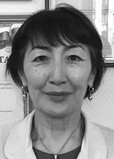Adaptive body responses rating in highly-skilled Yakut athletes by erythrocyte indices
Фотографии:
ˑ:
PhD E.I. Semenova1
Dr.Biol., Professor G.E. Mironova2
PhD Z.N. Krivoshapkina1
PhD L.D. Olesova1
PhD A.V. Efremova1
L.I. Konstantinova1
A.I. Yakovleva1
A.A. Grigorieva1
1Yakut Science Center of Complex Medical Problems, Yakutsk
2Ammosov North-Eastern Federal University, Yakutsk
The highly-skilled Yakut athletes have to live and train in the extreme climatic conditions of the Russian Far North and, therefore, their training process needs to be supported by accessible and dependable express test methods to control their adaptation processes. Some researchers recommend a variety of morpho-functional rating criteria to profile their body responses to stressors. The study was designed to measure the erythrocyte indices in highly-skilled Yakut athletes (n=169) including freestyle wrestlers (n=112) and boxers (n=57) aged 18-28 years. It was found that the specific (per 1 mcl) variations of hemoglobin, hematocrit, erythrocyte indices (MCV, MCH, MCHC) in the Yakut athletes are sport- and training-stage- specific. The expressed variations of the blood profiles versus the standard in some athletes in the precompetitive period may be interpreted as indicative of the drawbacks in the precompetitive weight loss systems. The expressed sag of the НGB and НСТ rates in the boxing subsample may be indicative of the hypochrome anemia due to the specific requirements of the competitive process. The growth of erythrocyte indices (МСН, МСНС) in some athletes, particularly in the precompetitive period, may be indicative of the tissue-level hypoxia and dehydration. The МСV growth commonly associated with the thickening of the erythrocyte membrane and spherical index variation may be interpreted as the bodily adaptation to the water-electrolyte balance in blood under hypotonic type. These adaptability conditions were found to be of limiting effect on the athletes’ physicality including the endurance and physical working capacity rates and, hence, on their competitive success rates.
Keywords: athletes, boxing, freestyle wrestling, Yakutia, erythrocyte indices.
References
- Avtsyn A.P., Zhavoronkov A,A., Rish M.A. et al Mikroelementozy cheloveka: etiologiya, klassifikatsiya, organopatologiya [Microelementoses of man: etiology, classification, organopathology]. Moscow: Meditsina publ., 1991, 496 p.
- Gushchin A.G. Vliyanie na reologicheskie svoystva, gazovy i kislotno-schelochnoy sostav krovi odnokratnykh myshechnykh nagruzok raznoy intensivnosti. Dis. kand. med. nauk [Influence on rheological properties, blood gas and acid-base parameters in single muscle loads of different intensity. PhD diss.]. Yaroslavl, 1994, 184 p.
- Degteva G.N. Sostoyanie eritrona u zhiteley severnykh territoriy [Erythron status in inhabitants of northern territories]. Ekologiya cheloveka [Human Ecology], 2004, no. 6, pp. 53-57.
- Durmanov N.D., Filimonov A.S. Diagnostika i korrektsiya narusheniy obmena zheleza v sporte vysshikh dostizheniy [Diagnostics and correction of iron metabolism disorders in elite sports]. Method. rec. for physicians. Moscow, 2010, 84 p.
- Kim L. B. Transport kisloroda pri adaptatsii cheloveka k usloviyam Arktiki i kardiorespiratornoy patologii [Transport of oxygen in human adaptation to Arctic conditions and cardiorespiratory pathology]. Novosibirsk: Nauka publ., 2015-216 p.
- Makarova G.A. Sportivnaya meditsina [Sports medicine]. Moscow, Sovetskiy Sport publ., 2003, 480 p.
- Muraviev A.V., Tikhomirova I.A. Fiziologicheskaya rol i mekhanizmy obiedineniya v agregaty [Fiziological role and mechanisms of association in aggregates]. Rossiyskiy fiziologicheskiy zhurnal [Russian Physiological Journal], 2007, no. 12, pp. 1382-1393.
- Olesova L.D., Okhlopkova E.D. Otsenka obespechennosti organizma sportsmenov makronutrientami [Assessment of athletes' macronutrients]. YMZh, 2006, no. 4, pp. 16-18.
- Panin L.E. Osobennosti energeticheskogo obmena [Features of energy exchange]. Mekhanizmy adaptatsii cheloveka v usloviyakh vysokikh shirot [Mechanisms of high latitude adaptation in man]. Leningrad; Meditsina publ., 1980, pp. 87-97.
- Semenova E.I. Morfologicheskie pokazateli perifericheskoy krovi vysokokvalifitsirovannykh sportsmenov [Morphological parameters of peripheral blood in highly skilled martial artists of Yakutia. PhD]. Yakutsk, 2010, 124 p.
- Semenova E. I., Mironova G. Ye., Krivoshapkina Z. N. et al Pokazateli perifericheskoy krovi sportsmenov Yakutii [Parameters of peripheral blood of Yakut athletes]. Proc. V international res.-pract, conference 'Scientific achievements of the third millennium' May 31, 2017 Pub.SPC "L Journal", New York, 2017, pp. 32–39.



 Журнал "THEORY AND PRACTICE
Журнал "THEORY AND PRACTICE